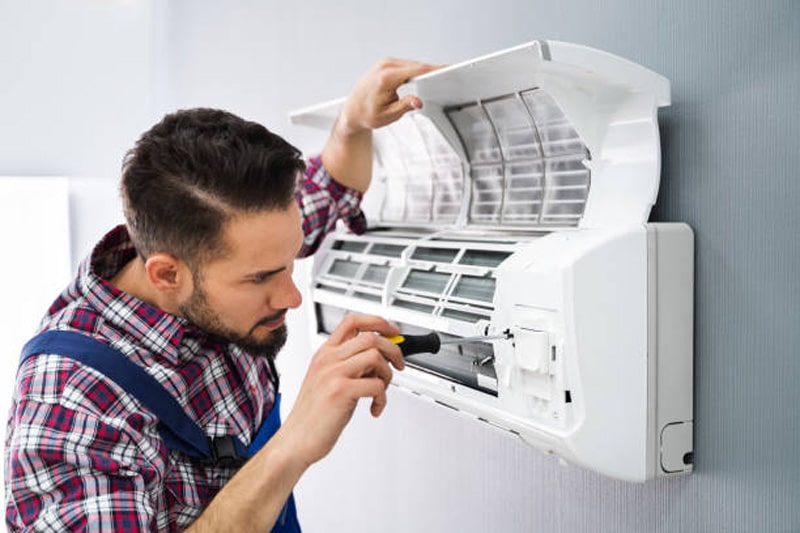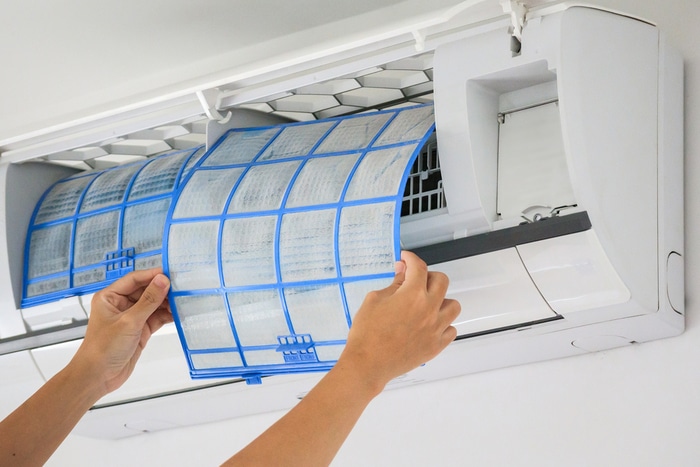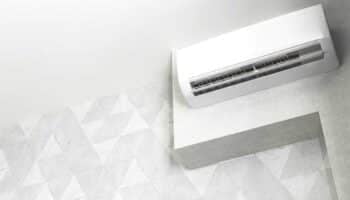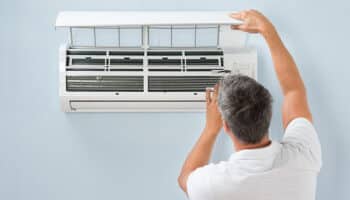We've independently reviewed this article to make sure it's as accurate as we can make it.
To find out more about our article creation and review process, check out our editorial guidelines.
Over the past several years ductless mini-split air conditioners have become increasingly popular. Thanks to the fact that they’re customizable and can be zoned, they’re often more popular than window or portable air conditioners.
However, they’ve gained a little bit of a bad rap, as many think that they’re high maintenance.
But that just isn’t true! In fact, they don’t require any more maintenance than any of the more traditional types of air conditioning. They’re even manufactured in a way that ensures easy access when it comes to things like filter maintenance and cleaning.
Having said that, they still require annual maintenance. So we’ve put together this maintenance and care guide to walk you through some general best practices and maintenance tips. Follow these, and your ductless air conditioner will last longer and cost you less to run.
Combined, the team at Appliance Analysts has decades of experience in HVAC and appliance repair. And we’re happy to share our knowledge with you!
Gather Your Gear
With a few exceptions, you’ll probably have most of these items available already.
- Garden hose with sprayer nozzle
- AC fin comb
- AC coil cleaner
- Microfiber clause
- Spray bottle with soap and water
- Screwdriver
- Wet Vac
If you don’t have a Wet Vac, they’re typically available to rent.
Ductless Air Conditioner Health Check — the Essentials
It’s always a good idea to make sure you have things installed and set up properly. This goes a long way towards great performance and efficiency.
#1 Leave it Running
The most important thing to remember when it comes to a ductless mini split is that you should leave it running 24/7. It takes less energy to maintain a cool room than it does to drop the temperature. And ductless systems achieve better efficiency when they operate consistently.
If you have a set schedule where you and your family are away from home, simply adjust the thermostat up by a few degrees for those periods of time, instead of turning the unit off.
#2 Reduce Heat Gain
The harder your ductless air conditioner has to work, the less efficient it is. With that in mind, reduce interior heat by keeping windows covered when there’s direct sunlight on them.
Ductless Air Conditioner Health Check — Follow Good Habits
Following good habits and best practices will help your ductless mini split run more efficiently.
If you want to save time and cost when it comes to maintenance and repairs, consider the following.

#1 Set the Fan to Auto
Your ductless air conditioner’s air handler has the option to adjust the fan speed manually or automatically. Set it to auto, and leave it.
#2 Allow for Airflow
If you have a multi system, with indoor units in different rooms, be sure to leave interior doors open. This allows for increased airflow and will help the system run more efficiently.
#3 Determining Temperature Settings
The temperature sensors on a ductless air conditioner are typically higher than where a traditional thermostat would be placed on the wall.
Most temperature recommendations, such as those by the US Department of Energy to set the thermostat at 78° during the cooling season are based on temperature readings at your level. With a ductless system, you may need to rely more on how you feel as opposed to the readings at your thermostat.
Ductless Air Conditioner Health Check — Maintenance
As mentioned earlier, ductless mini splits don’t require any more maintenance than more traditional air conditioners, despite newer technology. However, much like central air, they do have both indoor and outdoor units. And if you have a multi-unit, you’ll have to do your maintenance on each one.
#1 Clean the Outdoor Compressor
The outdoor unit houses your compressor, and it’s essential to keep the area around it clean and the interior clean.
1. Power off the unit.
2. Clear the area of any dirt or debris that may have collected around it.
3. Remove the fan grill, based on manufacturer requirements.
4. Remove any dead leaves or other debris lodged inside the unit and inspect the condenser coil. Brush off any dirt, and if any of the fins are bent you can attempt to straighten them using a fin comb.
5. Spray air conditioner coil cleaner or your own soap and water mixture on the interior walls of the unit and then use your garden hose to spray it off.
6. Carefully clean off the fan blades using soap and water and a microfiber cloth.
7. Rinse them down with your garden hose on a gentle setting, and then wipe them dry.
8. Check the condensate pan and clean it if necessary.
9. Reassemble the unit and power it back on.
#2 Clear the Drainpipe
Your system will have a drainpipe that runs through the wall between the inside and outside units. You should see it on the wall near where the indoor unit is installed.
1. Power off your air conditioner.
2. Attach a wet vac hose to the drainpipe outside your home. Let it run for a minute or two to give it a chance to suck out anything that might be collected in the pipe. You’ll likely need to use something like a paper towel to create a tight fit between the vacuum hose and the pipe.
#3 Clean the Filters
Unless your air conditioner has a different recommendation, the typical recommendation for ductless air conditioners is that filters should be cleaned every two weeks. This will not only improve your indoor air quality but will also prevent mold.

1. Power off your air conditioner.
2. Open up the indoor, wall-mounted unit by lifting the front panel.
3. Access and gently remove the two filters inside, being careful not to dislodge any of the dust and dirt from them.
4. Either using a soft brush or a low-powered vacuum cleaner, clean the dust from the filters. Then, using warm water, spray the filter clean and then allow it to air dry.
5. When completely dry, replace the filters.
Waiting until the filters are 100% dry is essential. Reinstalling wet or damp filters will lead to mold and or mildew growing on them.
6. Close the panel and restart your air conditioner.
You’ve Done It!
No matter what type of air conditioner you have, regular maintenance is key to a system that keeps you cool when you need it — and does so without breaking the bank.
By following the steps in this guide, you can be confident of the following.
- You’ll improve your indoor air quality
- You’ll prevent mold growth in your air conditioner
- Your mini-split will operate more efficiently
- You’ll have a better chance of your air conditioner lasting longer.
And you’ll stay cool on those hot summer days!







